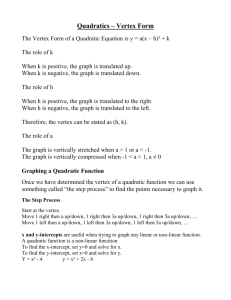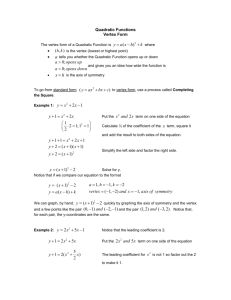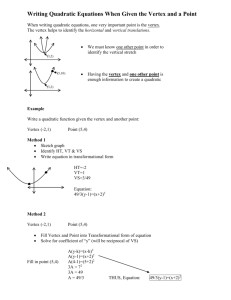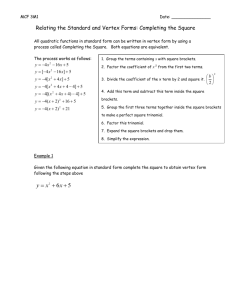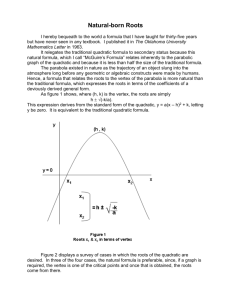Quadratic Functions: Standard to Vertex Form Worksheet
advertisement
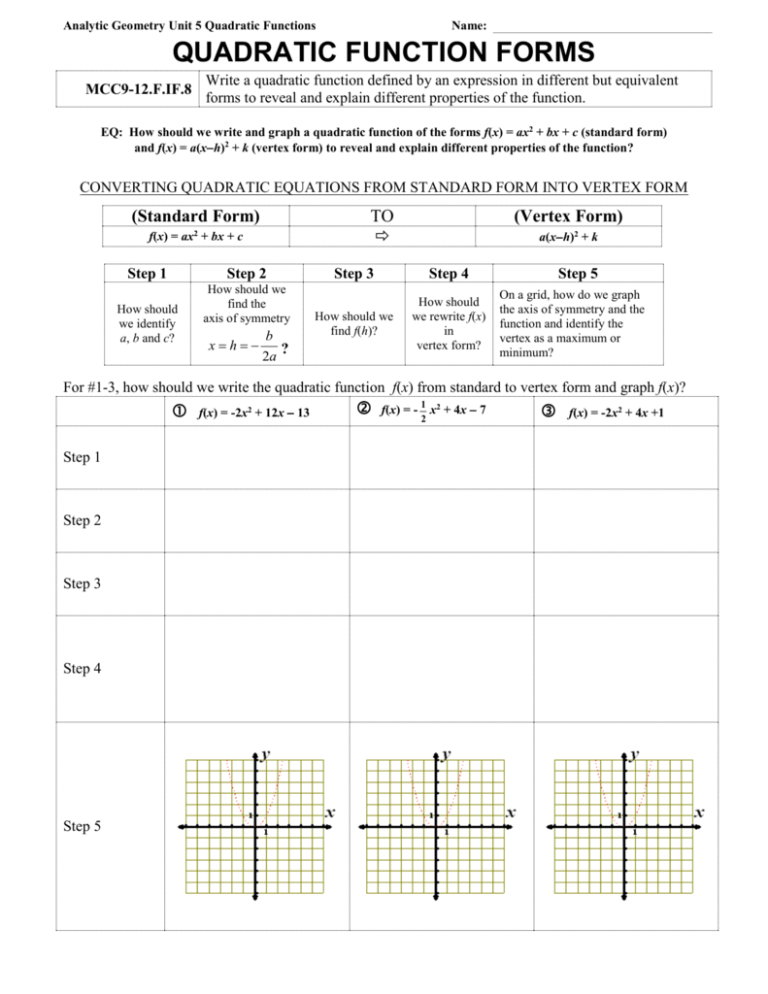
Analytic Geometry Unit 5 Quadratic Functions Name: QUADRATIC FUNCTION FORMS MCC9-12.F.IF.8 Write a quadratic function defined by an expression in different but equivalent forms to reveal and explain different properties of the function. EQ: How should we write and graph a quadratic function of the forms f(x) = ax2 + bx + c (standard form) and f(x) = a(xh)2 + k (vertex form) to reveal and explain different properties of the function? CONVERTING QUADRATIC EQUATIONS FROM STANDARD FORM INTO VERTEX FORM TO (Standard Form) f(x) = ax2 + bx + c Step 1 Step 2 How should we identify a, b and c? How should we find the axis of symmetry xh b ? 2a (Vertex Form) a(xh)2 + k Step 3 Step 4 How should we find f(h)? How should we rewrite f(x) in vertex form? Step 5 On a grid, how do we graph the axis of symmetry and the function and identify the vertex as a maximum or minimum? For #1-3, how should we write the quadratic function f(x) from standard to vertex form and graph f(x)? Step 1 Step 2 Step 3 Step 4 Step 5 f(x) = -2x2 + 12x 13 1 2 f(x) = - x2 + 4x 7 f(x) = -2x2 + 4x +1 Analytic Geometry Unit 5 Quadratic Functions Name: QUADRATIC FUNCTION FORMS Write a quadratic function defined by an expression in different but equivalent forms to reveal and explain different properties of the function. MCC9-12.F.IF.8 EQ: How should we write and graph a quadratic function of the forms f(x) = ax2 + bx + c (standard form) and f(x) = a(xh)2 + k (vertex form) to reveal and explain different properties of the function? CONVERTING QUADRATIC EQUATIONS FROM STANDARD FORM INTO VERTEX FORM TO (Standard Form) 2 f(x) = ax + bx + c Step 1 Step 2 How should we identify a, b and c? How should we find the axis of symmetry xh b ? 2a (Vertex Form) a(xh)2 + k Step 3 Step 4 How should we find f(h)? How should we rewrite f(x) in vertex form? Step 5 On a grid, how do we graph the axis of symmetry and the function and identify the vertex as a maximum or minimum? For #4-6, how should we write the quadratic function f(x) from standard to vertex form and graph f(x)? Step 1 Step 2 Step 3 Step 4 Step 5 1 2 f(x) = - x2 2x +1 f(x) = 2x2 12x + 17 f(x) = 1 2 x2 2x 3 Analytic Geometry Unit 5 Quadratic Functions Name: QUADRATIC FUNCTION FORMS Write a quadratic function defined by an expression in different but equivalent forms to reveal and explain different properties of the function. MCC9-12.F.IF.8 EQ: How should we write and graph a quadratic function of the forms f(x) = ax2 + bx + c (standard form) and f(x) = a(xh)2 + k (vertex form) to reveal and explain different properties of the function? CONVERTING QUADRATIC EQUATIONS FROM VERTEX FORM INTO STANDARD FORM TO (Vertex Form) 2 a(xh) + k Step 1 Step 2 On the graph, how should we identify the axis of symmetry, vertex and rate of change? How should we write the equation of the graph in vertex form? (Standard Form) f(x) = ax2 + bx + c Step 3 Step 4 Step 5 How should we write the binomial square as two binomials? How should we expand the binomial square into a trinomial using FOIL? How should we combine like terms to obtain standard form? For #7-9, how should we write the graph of the quadratic function f(x) from vertex to standard form? 7 Step 1 Step 2 Step 3 Step 4 Step 5 8 9 Analytic Geometry Unit 5 Quadratic Functions Name: QUADRATIC FUNCTION FORMS Write a quadratic function defined by an expression in different but equivalent forms to reveal and explain different properties of the function. MCC9-12.F.IF.8 EQ: How should we write and graph a quadratic function of the forms f(x) = ax2 + bx + c (standard form) and f(x) = a(xh)2 + k (vertex form) to reveal and explain different properties of the function? CONVERTING QUADRATIC EQUATIONS FROM VERTEX FORM INTO STANDARD FORM TO (Vertex Form) 2 a(xh) + k Step 1 Step 2 On the graph, how should we identify the axis of symmetry, vertex and rate of change? How should we write the equation of the graph in vertex form? (Standard Form) f(x) = ax2 + bx + c Step 3 Step 4 Step 5 How should we write the binomial square as two binomials? How should we expand the binomial square into a trinomial using FOIL? How should we combine like terms to obtain standard form? For #10-12, how should we write the graph of the quadratic function f(x) from vertex to standard form? 10 Step 1 Step 2 Step 3 Step 4 Step 5 11 12 Analytic Geometry Unit 5 Quadratic Functions Name: QUADRATIC FUNCTION FORMS MCC9-12.F.IF.8 Write a quadratic function defined by an expression in different but equivalent forms to reveal and explain different properties of the function. EQ: How should we write and graph a quadratic function of the forms f(x) = ax2 + bx + c (standard form) and f(x) = a(xh)2 + k (vertex form) to reveal and explain different properties of the function? For #13-16, the absolute value of the rate of change for the quadratic function is 1 2 . How should we write a quadratic function in vertex form and standard form that satisfy the given properties? PROPERTIES 13 The quadratic function f(x) has these characteristics: The vertex is located at ( 8, -2 ). The range is -2 y . 14 The quadratic function f(x) has these characteristics: The axis of symmetry is x = -6. The range is - y 4. 15 The quadratic function f(x) has these characteristics: The vertex is located at ( 4, -1 ). The range is - y -1. 16 The quadratic function f(x) has these characteristics: The axis of symmetry is x = 2. The range is 3 y . VERTEX FORM STANDARD FORM Analytic Geometry Unit 5 Quadratic Functions Name: QUADRATIC FUNCTION FORMS MCC9-12.F.IF.8 Write a quadratic function defined by an expression in different but equivalent forms to reveal and explain different properties of the function. EQ: How should we write and graph a quadratic function of the forms f(x) = ax2 + bx + c (standard form) and f(x) = a(xh)2 + k (vertex form) to reveal and explain different properties of the function? For #17-20, the absolute value of the rate of change for the quadratic function is 2. How should we write a quadratic function in vertex form and standard form that satisfy the given properties? CHARACTERISTICS 17 The quadratic function f(x) has these characteristics: The vertex is located at ( 4, -5 ). The range is -5 y . 18 The quadratic function f(x) has these characteristics: The axis of symmetry is x = 8. The range is - y -5. 19 The quadratic function f(x) has these characteristics: The vertex is located at ( 6, -3 ). The range is - y -3. 20 The quadratic function f(x) has these characteristics: The axis of symmetry is x = -2. The range is 4 y . VERTEX FORM STANDARD FORM
